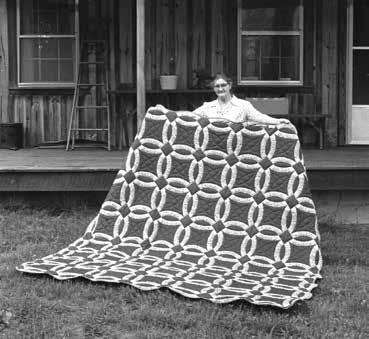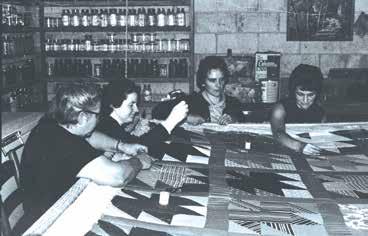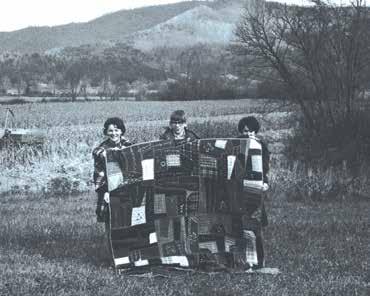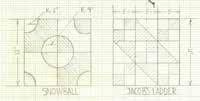
5 minute read
Foxfire: “A Quilt is Something Human
Adapted by Kami Ahrens
Quilts were handmade by people for people. Every phase of their production was permeated by giving and sharing, from the trading of scraps and patterns and the actual production in “bees,” to the giving away of the final finished work; quilting is a human activity in its essence. There is something about a quilt that says people, friendship, community, family, home, and love. Originally the plan for this project [in 1968] was to find all the patterns that were native to this county. That soon proved to be impossible, for quilt patterns were like ballads: they moved constantly from community to community over surprisingly great distances. Farmers’ journals, newspaper columns, and even quilt pattern companies spread them even farther. Most patterns also have different names, making their origins difficult to trace. The 1960s saw a dramatic revival of interest in textile arts like quilting. One explanation might be the statement made by Mrs. Claude Darnell: “There’s lots of people that wants to go back to the old times.”
Basically, the quilt itself consists of a bottom lining, a stuffing of cotton or wool, a top lining, and the top itself. The top is made of a number of squares joined by cloth borders or directly to each other. These squares are usually made up of the same pattern, but can be made by different individuals. In 1968, Foxfire student Emma Jean Buchanan witnessed the most popular way of putting a quilt together: the quilting bee. Each woman that gathered at Mrs. Maggie Vinson’s home had previously completed at least one Dutch Boy or Dutch Girl square. The squares Edith Darnell with her quilt


had all been gathered up, and by the time the women arrived, they had been sewn together into the completed top. Emma Jean wrote down some of her observations:
“The women sit around the quilt laughing and joking as if it isn’t a job at all. They never seem to get tired or want to go home. They all seem so content. The gossip is flowing as if I weren’t even around. This is my first quilting, so I sit there in amusement not knowing what will happen next. As I watch them making the final stitches I wonder just why would these women spend their time quilting when it’s cheaper to buy a blanket? Might it be that they quilt just for the social enjoyment?” We asked Edith Darnell the same question:
“It helps bring people together when they have quiltin’. It just seems like lots a’pleasure. You’re quiltin’, you don’t know you’re quiltin’—a’talkin’ and a’quiltin’ too. And y’have lunch. I used t’enjoy goin’ t’the quiltin’s.” Some of our other contacts remembered quiltings from their youth: Margaret Norton: “People would work all fall piecin’ quilt tops, and when they got ‘em all pieced, they’d invite in all the neighbors and have a quiltin’ and that quilt would be for th’person that invited ‘em in. And whoever they had th’ quiltin’ for furnished all of ‘em dinner. If it was at your house and it was for you, you’d furnish th’ whole dinner—even if there was twenty women there. They could quilt one out in a day, easy. Lots of times we’ve had quilts out at breakfast and quilted two.”
Marinda Brown: “People used to get together and they’d just put up one. They could make as many days out of it as they wanted to. They’d piece one for one family, set in and draw another one for another family, y’know; just kind of kept it goin’.” Annie Perry: “They had quiltin’s, but I never could quilt. My stitches
were so long you’d have to keep your toenails broke off t’keep from getting ‘em hung! People were neighbors. They all helped each other to do things. If you got anything to do now, you do it yourself or you let it go undone—whichever you want to.”
The most captivating custom, however, as mentioned earlier, was that of the Friendship Quilt. This could be any pattern, but each woman often embroidered her own name on the square. Ada Kelly told us: “The girls had a custom of making Friendship Quilts. One person would keep on ‘til she had enough blocks to make a quilt and then all those girls would get together and quilt that quilt. And the one that started it around got the quilt. That was a very common thing in my girlhood days. A name was supposed to be put on the quilt of everyone that pieced a square and they valued them. It was a keepsake really.” Such quilts were made by the ladies of the community whenever a young person from that community got married; when a neighbor lost his house by fire; for a newborn child; or just for a keepsake. When a boy became a man, he sometimes received one too. Edith Darnell said: Connie Burrell with her grandmother’s flower garden quilt

“We made ‘em along when the boys was about your age. You know, everyone sent out a square and everybody’d piece one for it. Everywhere the square went, everybody pieced one to go with it. When they got the quilt done, all that pieced the square went and helped quilt it. Then they’d wrap [the boy they did the quilt for] up in the quilt when they got it done.” Fancy or plain, however, the fact remains that quilts seem to us symbolic of some of our finer human qualities. Perhaps this revival of interest is a hopeful sign for us all. Visit www.foxfire.org/collections/ to see some of Foxfire’s own quilts! Adapted from the Foxfire magazine, vol. 3 no 3, 1969 pg. 5-7, 44-49 and vol. 5 no 1&2, 1971 pg. 101


Foxfire students with antique friendship quilt

Quilt patterns that were used by many quilters










